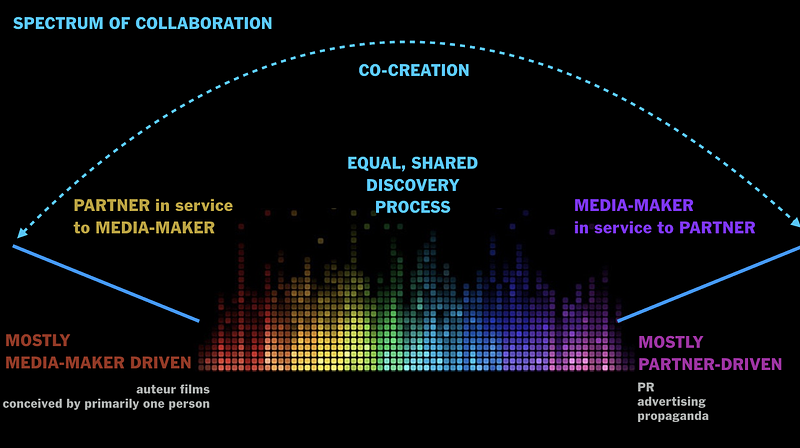
Graphic: Spectrum of Collaboration
Co-creation may not be used for all stages of the media-making journey, especially in long-term, ongoing projects. The following diagram, excerpted from the Collective Wisdom report, suggests how co-creation sits in the range of a joint discovery process, a parallel track between partners, in which no partner is driving—rather, all are co-pilots.

In our research on co-creation, we learned about how this spectrum plays out in the real world. Hank Willis Thomas, a Brooklyn-based conceptual artist, said that one of the biggest challenges of co-creation is understanding that partners and relationships come and go, but, in the long view, people may also return. Heather Croall described co-creation broadly as moving from the abstract to the specific, from divergent to cohesive systems that require different skills and relationships along the way. So, too, Ethan Zuckerman, Director of MIT Media Lab’s Center for Civic Media, described his process as iterative and changing players as the needs require. Co-creation resides on a spectrum and may be used only at certain stages of a larger project.
This article is part of Collective Wisdom, an Immerse series created in collaboration with Co-Creation Studio at MIT Open Documentary Lab. Immerse’s series features excerpts from MIT Open Documentary Lab’s larger field study — Collective Wisdom: Co-Creating Media within Communities, across Disciplines and with Algorithms — as well as bonus interviews and exclusive content.
Immerse is an initiative of the MIT Open DocLab and The Fledgling Fund, and it receives funding from Just Films | Ford Foundation and the MacArthur Foundation. IFP is our fiscal sponsor. Learn more here. We are committed to exploring and showcasing media projects that push the boundaries of media and tackle issues of social justice — and rely on friends like you to sustain ourselves and grow. Join us by making a gift today.